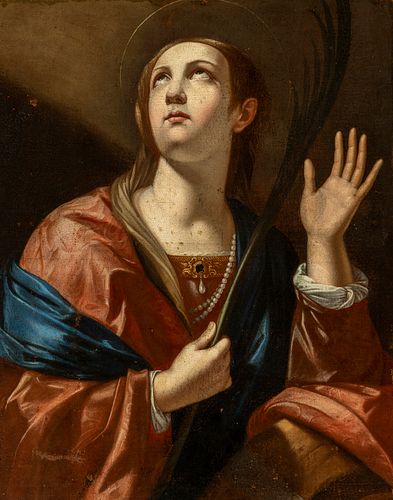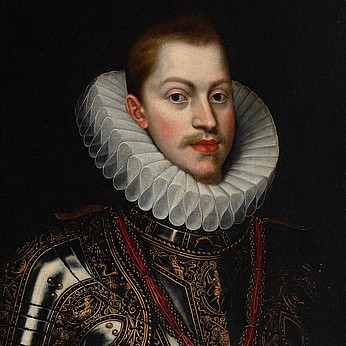Italian school, circle of SIMON VOUET; XVII century. "Saint Catherine of Alexandria". Oil on canvas. Relined.
Lot 56
About Seller
Setdart Auction House
Carrer Aragó 346
Barcelona
Spain
Setdart Subastas was born in 2004 and is currently the first online art auction in Spain with solidity, prestige and reliability guaranteed by our more than 60,000 users. Setdart has a young, dynamic and enterprising team ready to successfully manage the purchase and sale of art works through custom...Read more
Estimate:
EUR€7,000 - EUR€8,000
$7,526.88 - $8,602.15
Absentee vs Live bid
Two ways to bid:
- Leave a max absentee bid and the platform will bid on your behalf up to your maximum bid during the live auction.
- Bid live during the auction and your bids will be submitted real-time to the auctioneer.
Bid Increments
| Price | Bid Increment |
|---|---|
| EUR€0 | EUR€10 |
| EUR€200 | EUR€25 |
| EUR€500 | EUR€50 |
| EUR€1,000 | EUR€100 |
| EUR€3,000 | EUR€200 |
| EUR€5,000 | EUR€500 |
| EUR€10,000 | EUR€1,000 |
| EUR€20,000 | EUR€2,000 |
| EUR€50,000 | EUR€5,000 |
About Auction
By Setdart Auction House
Nov 24, 2021
Set Reminder
2021-11-24 09:00:00
2021-11-24 09:00:00
America/New_York
Bidsquare
Bidsquare : Old Masters, Day 1
https://www.bidsquare.com/auctions/setdart-auction-house/old-masters-day-1-7873
Setdart Auction House sofia@setdart.com
Setdart Auction House sofia@setdart.com
- Lot Description
Italian school, circle of SIMON VOUET; XVII century. "Saint Catherine of Alexandria". Oil on canvas. Relined. Presents frame with damage. Measurements: 90 x 71.5 cm; 112 x 94 cm (frame). The work stands out for a great clarity in the capture of the qualities, the prese cision of the drawing, and an aesthetic inheritance of classicist character. However, the light treatment of the piece, largely reminds us of a veiled tenebrism, similar to that which characterized Vouet's painting. Through a quick and precise brushstroke the author of this work configures a scene, sober and regal but full of drama where he presents the figure of Saint Catherine. The cult of Saint Catherine was widespread throughout Europe from the 6th century onwards, she is included in the group of the holy helpers and is invoked against sudden death. Catherine was born around 290 in the bosom of a noble family of Alexandria. Endowed with a great intelligence, she soon stood out for her extensive studies, which placed her on the same level as the greatest poets and philosophers of the time. One night Christ appeared to her and she decided, at that moment, to consecrate her life to him and to consider herself his fiancée, in a sort of mystical marriage. When Emperor Maximian came to Alexandria to preside over a great pagan feast, Catherine took the opportunity to try to convert him to Christianity, which aroused his anger. To test her, Maximian imposed on her a philosophical debate with fifty wise men whom she would try to convert. Catherine succeeded, provoking the emperor's wrath. The emperor had the sages executed, but not before proposing to the saint that she marry one of them, to which she flatly refused. The emperor then ordered her to be tortured using a machine with spiked wheels. Miraculously, the wheels broke when they touched Catherine's body, so she was finally beheaded. A French Baroque painter, Simon Vouet probably began his training with his father, the painter Laurent Vouet, and is cited by André Félibien in England at the age of fourteen, already a professional portraitist. In fact, his mastery in this genre would lead him to visit Constantinople in 1611 accompanying the French ambassador, to go to Venice the following year. Finally, two years later, he settled in Rome, protected by the Barberini family and the French Crown. He remained in the Italian capital until 1627, and there he achieved great success among the nobility and clergy sympathetic to France. In fact, he became director of the Academy of St. Luke in 1624. In Rome Vouet especially admired the work of Caravaggio, whose language would define the French master's youthful style. However, his painting will quickly evolve towards forms more akin to classicism, through the influence of the neo-Venetianist current that ran through Rome by the hand of artists like Lanfranco. He will also be receptive to the influence of the Roman-Bolognese classicism of Carracci, Guercino and Reni, especially in his chromatism, which evolves towards a greater clarity, and also in his increasingly harmonious compositions. In 1627 he returned to France, called by Louis XIII to be court painter. In Paris Vouet became the most influential painter of his time, and in fact introduced the influence of the Italian Baroque in France, especially the currents derived from the work of Veronese. Precisely the influence of the latter can be seen in the great decorations that Vouet made in the time of Louis XIII and Cardinal Richelieu. Already in this stage of maturity he will be enormously prolific, making both oil paintings and large decorative frescoes for the king and his court. Likewise, as the undisputed king of French painting of his time, he was the master of a whole generation, counting among his pupils outstanding artists such as Charles Lebrun or Nicolas Mignard.
- Shipping Info
-
In-house shipping available. Please inquire at admin@setdart.com.
-
- Buyer's Premium



 EUR
EUR CAD
CAD AUD
AUD GBP
GBP MXN
MXN HKD
HKD CNY
CNY MYR
MYR SEK
SEK SGD
SGD CHF
CHF THB
THB















